Measuring the Impact of Recovery Resource Delay on Traffic Incident Management Clearance Times
Abstract
1. Introduction
2. Background
3. Research Objective
4. Traffic Incident Management Event Sequence
- T0—time at which incident actually occurs;
- T1—time of first recordable awareness of incident by a responsible agency;
- T2—time at which incident is verified;
- T3—time at which required response for the incident is identified and dispatched;
- T4—time at which response arrives on scene;
- T5—time of first confirmation that all lanes are available for traffic flow;
- T6—time at which the last responder has left the scene;
- T7—time at which traffic flow returns to normal.
- Detection Time (DT): The time from when the incident occurs (T0) to when it is reported (T1).
- Verification Time (VT): The time when the incident was reported (T1) to when it was verified (T2).
- Response Time (RT): The time from verification (T2) to the arrival of responders (T4).
- Roadway Clearance Time (RCT): The time from the initial detection (T1) to all the travel lanes reopening (T5).
- Incident Clearance Time (ICT): The time from the initial detection (T1) to when all responders have left the scene (T6).
- Time to Return to Normal Flow: The time from when the incident occurs (T0) to when traffic conditions return to normal flow (T7).
Improving the Fidelity of FHWA TIM Reference Points
5. Repository of After-Actions
- An overturned semi blocking four lanes for 3 h and 48 min with a total incident duration of 4 h and 31 min. The estimated RRMT was 92 min.
- A passenger vehicle slide-off with entanglement in a cable median barrier. One lane blocked for 3 h with a total incident duration of 3 h and 12 min. The estimated RRMT was 112 min.
- A passenger vehicle fire with two lanes blocked for 18 min and a total incident duration of 1 h and 4 min. The estimated RRMT was 34 min.
- A semi fire with four lanes blocked for 6 h and a total incident duration of 7 h and 46 min. The estimated RRMT was 34 min.
6. Case Studies and Example Extraction of TIM Event Sequence
6.1. Case Study 1: Overturned Semi
Example of Extraction of TIM Event Sequence
6.2. Case Study 2: Passenger Vehicle Slide-off
6.3. Case Study 3: Passenger Vehicle Fire
6.4. Case Study 4: Semi Fire
6.5. Case Studies of TIM Event Sequences and Summary Intervals
7. Results and Discussion
- Response time;
- Recovery resource mobilization time;
- Incident clearance time.
8. Conclusions
Limitations and Future Work
Author Contributions
Funding
Institutional Review Board Statement
Informed Consent Statement
Data Availability Statement
Acknowledgments
Conflicts of Interest
Abbreviations
| ANRR | All Necessary Recovery Resources |
| ARIES | Automated Reporting Information Exchange System |
| CV | Connected Vehicles |
| DT | Detection Time |
| EMS | Emergency Medical Services |
| FHWA | Federal Highway Administration |
| ICT | Incident Clearance Time |
| ISP | Indiana State Police |
| ITS | Intelligent Transportation Systems |
| MM | Mile Marker |
| NHTSA | National Highway Traffic Safety Administration |
| OL | Outer Loop |
| RCT | Roadway Clearance Time |
| RRMT | Recovery Resource Mobilization Time |
| RT | Response Time |
| TIM | Traffic Incident Management |
| TMC | Traffic Management Center |
| VT | Verification Time |
References
- USDOT. The Roadway Safety Problem. Available online: https://www.transportation.gov/NRSS/SafetyProblem (accessed on 24 March 2025).
- National Center for Statistics and Analysis. Traffic Safety Facts 2022: A Compilation of Motor Vehicle Traffic Crash Data; Publication DOT HS 813 656; National Highway Traffic Safety Administration: Washington, DC, USA, 2024.
- Wright, B.; Zou, Y.; Wang, Y. Impact of Traffic Incidents on Reliability of Freeway Travel Times. Transp. Res. Rec. J. Transp. Res. Board 2015, 2484, 90–98. [Google Scholar] [CrossRef]
- Zhang, H.; Khattak, A. What Is the Role of Multiple Secondary Incidents in Traffic Operations? J. Transp. Eng. 2010, 136, 986–997. [Google Scholar] [CrossRef]
- Khattak, A.; Wang, X.; Zhang, H. Are Incident Durations and Secondary Incidents Interdependent? Transp. Res. Rec. J. Transp. Res. Board 2009, 2099, 39–49. [Google Scholar] [CrossRef]
- Kwon, J.; Mauch, M.; Varaiya, P. Components of Congestion: Delay from Incidents, Special Events, Lane Closures, Weather, Potential Ramp Metering Gain, and Excess Demand. Transp. Res. Rec. J. Transp. Res. Board 2006, 1959, 84–91. [Google Scholar] [CrossRef]
- Mekker, M.M.; Remias, S.M.; McNamara, M.L.; Bullock, D.M. Characterizing Interstate Crash Rates Based on Traffic Congestion Using Probe Vehicle Data; Purdue University: West Lafayette, IN, USA, 2020. [Google Scholar]
- ResponderSafety.com (or Emergency Responder Safety Institute). 2024 Struck-By-Vehicle Fatality Incidents Reports. ResponderSafety.com. Available online: https://www.respondersafety.com/resources/struck-by-incidents/ (accessed on 22 July 2025).
- Yu, L.; Bill, A.R.; Chitturi, M.V.; Noyce, D.A. On-Duty Struck-By Crashes: Characteristics and Contributing Factors. Transp. Res. Rec. J. Transp. Res. Board 2013, 2386, 112–120. [Google Scholar] [CrossRef]
- Ye, Q.; Fang, Y.; Zheng, N. Performance Evaluation of Struck-by-Accident Alert Systems for Road Work Zone Safety. Autom. Constr. 2024, 168, 105837. [Google Scholar] [CrossRef]
- Khan, M.; Gbiengu, P.; Ibrahium, A.; Nnaji, C. Investigating Patterns and Causes of Struck-by Accidents in Roadway Construction Projects. Int. J. Occup. Saf. Ergon. 2025, 1–22. [Google Scholar] [CrossRef]
- Corbin, J.; Vasconez, K.C.; Helman, D. Unifying Incident Response. Public Roads 2007, 71, 23–30. [Google Scholar]
- Nam, D.; Mannering, F. An Exploratory Hazard-Based Analysis of Highway Incident Duration. Transp. Res. Part A Policy Pract. 2000, 34, 85–102. [Google Scholar] [CrossRef]
- Islam, N.; Adanu, E.K.; Hainen, A.M.; Burdette, S.; Smith, R.; Jones, S. Evaluating the Impact of Freeway Service Patrol on Incident Clearance Times: A Spatial Transferability Test. J. Adv. Transp. 2022, 2022, 5272747. [Google Scholar] [CrossRef]
- Ma, Y.; Chowdhury, M.; Fries, R.; Ozbay, K. Harnessing the Power of Microscopic Simulation to Evaluate Freeway Service Patrols. J. Transp. Eng. 2009, 135, 427–439. [Google Scholar] [CrossRef]
- Salum, J.H.; Sando, T.; Alluri, P.; Kitali, A. Impact of Freeway Service Patrols on Incident Clearance Duration: Case Study of Florida’s Road Rangers. J. Transp. Eng. Part A Syst. 2020, 146. [Google Scholar] [CrossRef]
- Dougald, L.E.; Demetsky, M.J. Assessing Return on Investment of Freeway Safety Service Patrol Programs. Transp. Res. Rec. J. Transp. Res. Board 2008, 2047, 19–27. [Google Scholar] [CrossRef]
- Latoski, S.P.; Pal, R.; Sinha, K.C. Cost-Effectiveness Evaluation of Hoosier Helper Freeway Service Patrol. J. Transp. Eng. 1999, 125, 429–438. [Google Scholar] [CrossRef]
- Liu, J.; Fu, X.; Hainen, A.; Yang, C.; Villavicencio, L.; Horrey, W.J. Evaluating the Impacts of Vehicle-Mounted Variable Message Signs on Passing Vehicles: Implications for Protecting Roadside Incident and Service Personnel. J. Intell. Transp. Syst. 2024, 28, 846–866. [Google Scholar] [CrossRef]
- Islam, N.; Adanu, E.K.; Hainen, A.M.; Burdette, S.; Smith, R.; Jones, S. A Comparative Analysis of Freeway Crash Incident Clearance Time Using Random Parameter and Latent Class Hazard-Based Duration Model. Accid. Anal. Prev. 2021, 160, 106303. [Google Scholar] [CrossRef]
- Alkaabi, A.M.S.; Dissanayake, D.; Bird, R. Analyzing Clearance Time of Urban Traffic Accidents in Abu Dhabi, United Arab Emirates, with Hazard-Based Duration Modeling Method. Transp. Res. Rec. J. Transp. Res. Board 2011, 2229, 46–54. [Google Scholar] [CrossRef]
- Ding, C.; Ma, X.; Wang, Y.; Wang, Y. Exploring the Influential Factors in Incident Clearance Time: Disentangling Causation from Self-Selection Bias. Accid. Anal. Prev. 2015, 85, 58–65. [Google Scholar] [CrossRef]
- Garib, A.; Radwan, A.E.; Al-Deek, H. Estimating Magnitude and Duration of Incident Delays. J. Transp. Eng. 1997, 123, 459–466. [Google Scholar] [CrossRef]
- Ghosh, I.; Savolainen, P.T.; Gates, T.J. Examination of Factors Affecting Freeway Incident Clearance Times: A Comparison of the Generalized F Model and Several Alternative Nested Models. J. Adv. Transp. 2014, 48, 471–485. [Google Scholar] [CrossRef]
- Tavassoli Hojati, A.; Ferreira, L.; Washington, S.; Charles, P. Hazard Based Models for Freeway Traffic Incident Duration. Accid. Anal. Prev. 2013, 52, 171–181. [Google Scholar] [CrossRef] [PubMed]
- Hou, L.; Lao, Y.; Wang, Y.; Zhang, Z.; Zhang, Y.; Li, Z. Modeling Freeway Incident Response Time: A Mechanism-Based Approach. Transp. Res. Part C Emerg. Technol. 2013, 28, 87–100. [Google Scholar] [CrossRef]
- Sakhare, R.S.; Desai, J.; Mathew, J.K.; McGregor, J.; Kachler, M.; Bullock, D.M. Measuring and Visualizing Freeway Traffic Conditions: Using Connected Vehicle Data; Joint Transportation Research Program: West Lafayette, IN, USA, 2024. [Google Scholar]
- Mathew, J.K.; Malackowski, H.A.; Gartner, C.M.; Desai, J.; Cox, E.D.; Habib, A.F.; Bullock, D.M. Methodology for Automatically Setting Camera View to Mile Marker for Traffic Incident Management. J. Transp. Technol. 2023, 13, 708–730. [Google Scholar] [CrossRef]
- Overall, M.; Mukai, J.; Sakhare, R.S.; Desai, J.; Horton, D.; Bullock, D. Repository of After-Action Reports for Traffic Incident Management (TIM); Joint Transportation Research Program: West Lafayette, IN, USA, 2025. [Google Scholar]

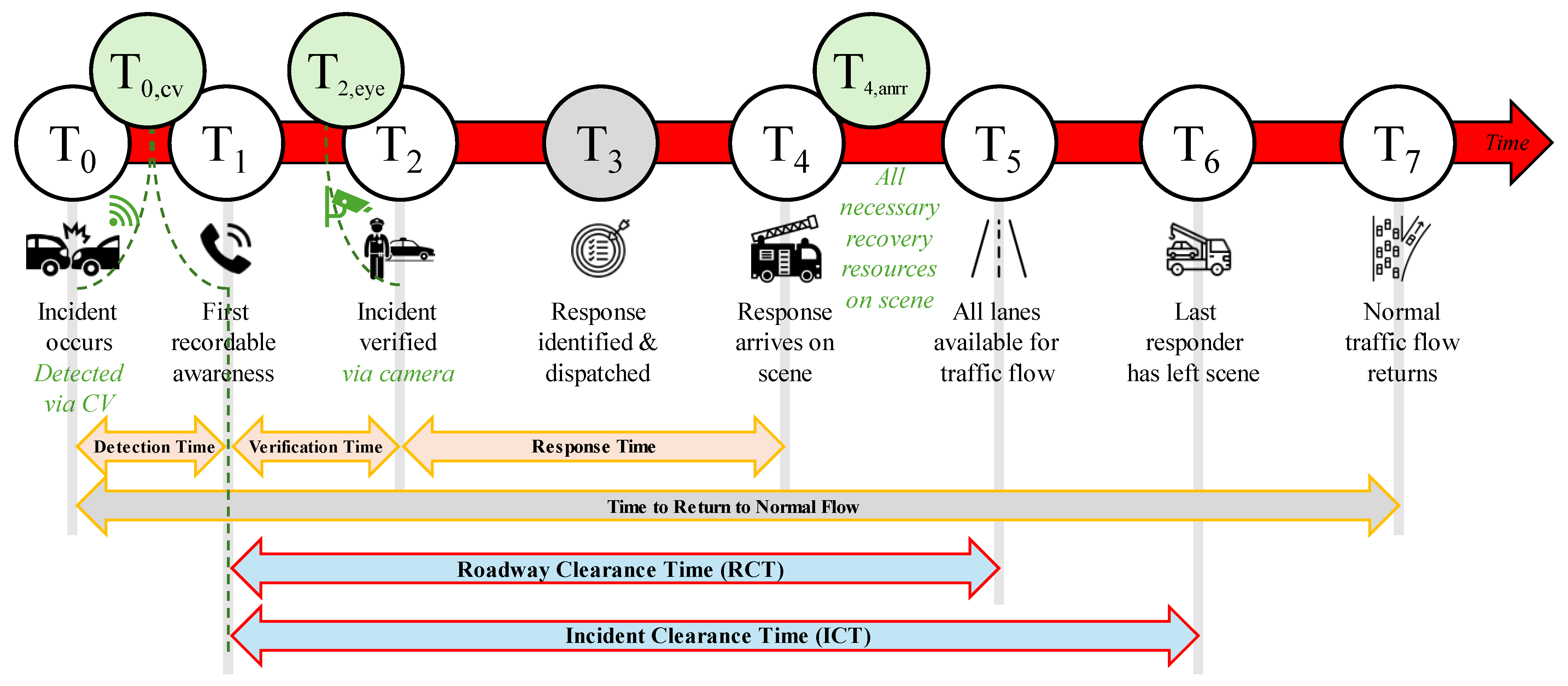
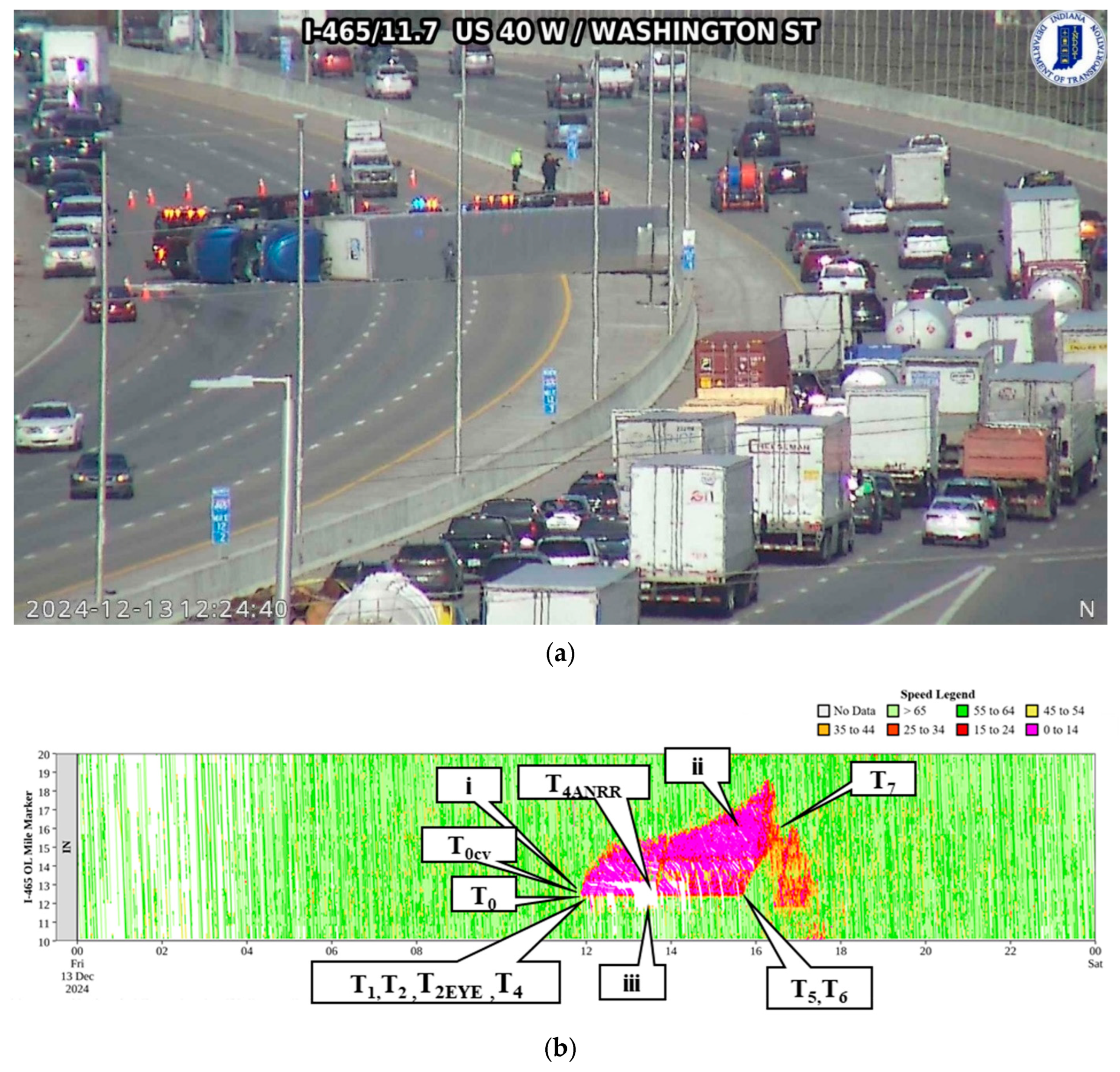

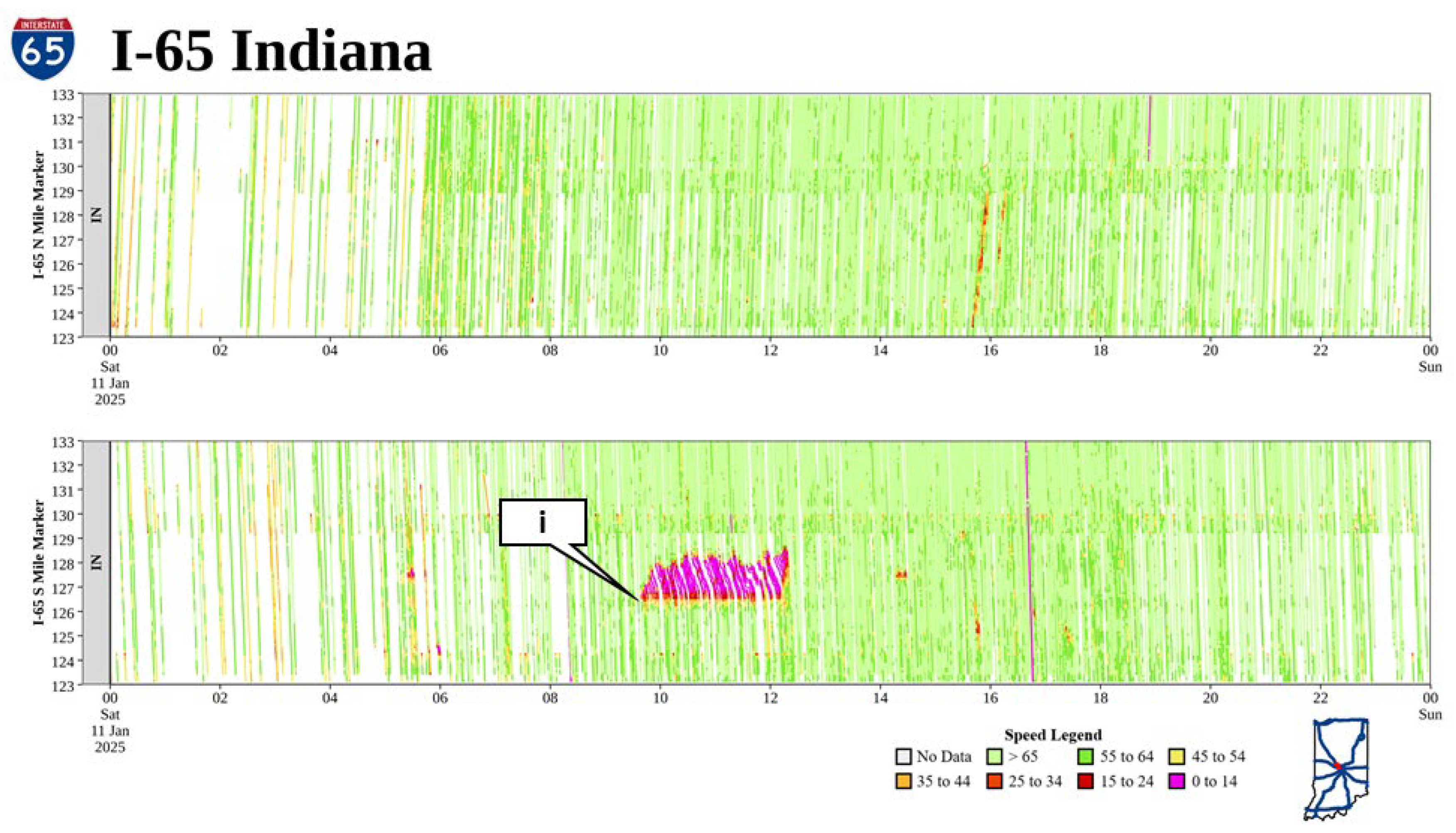






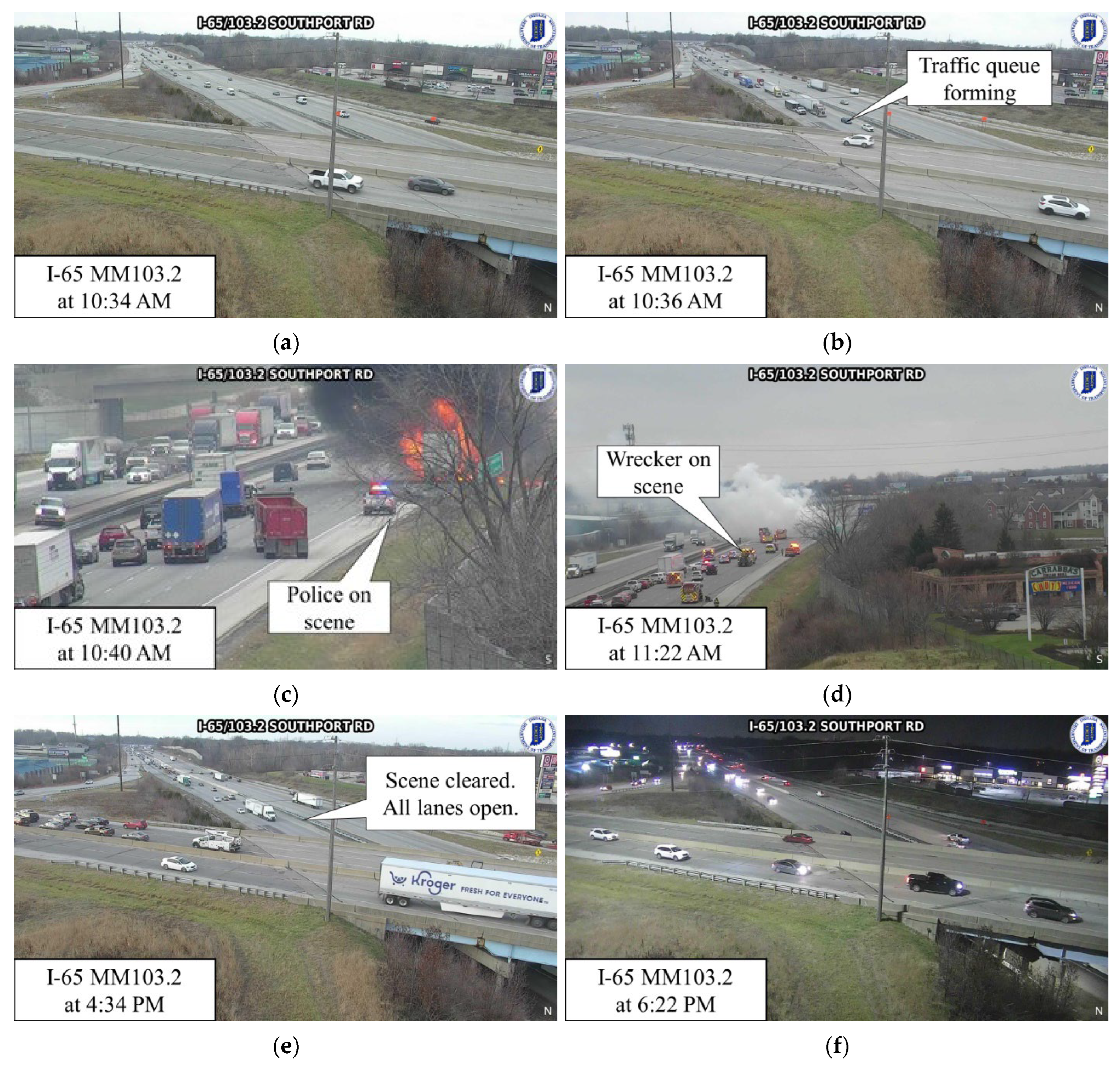

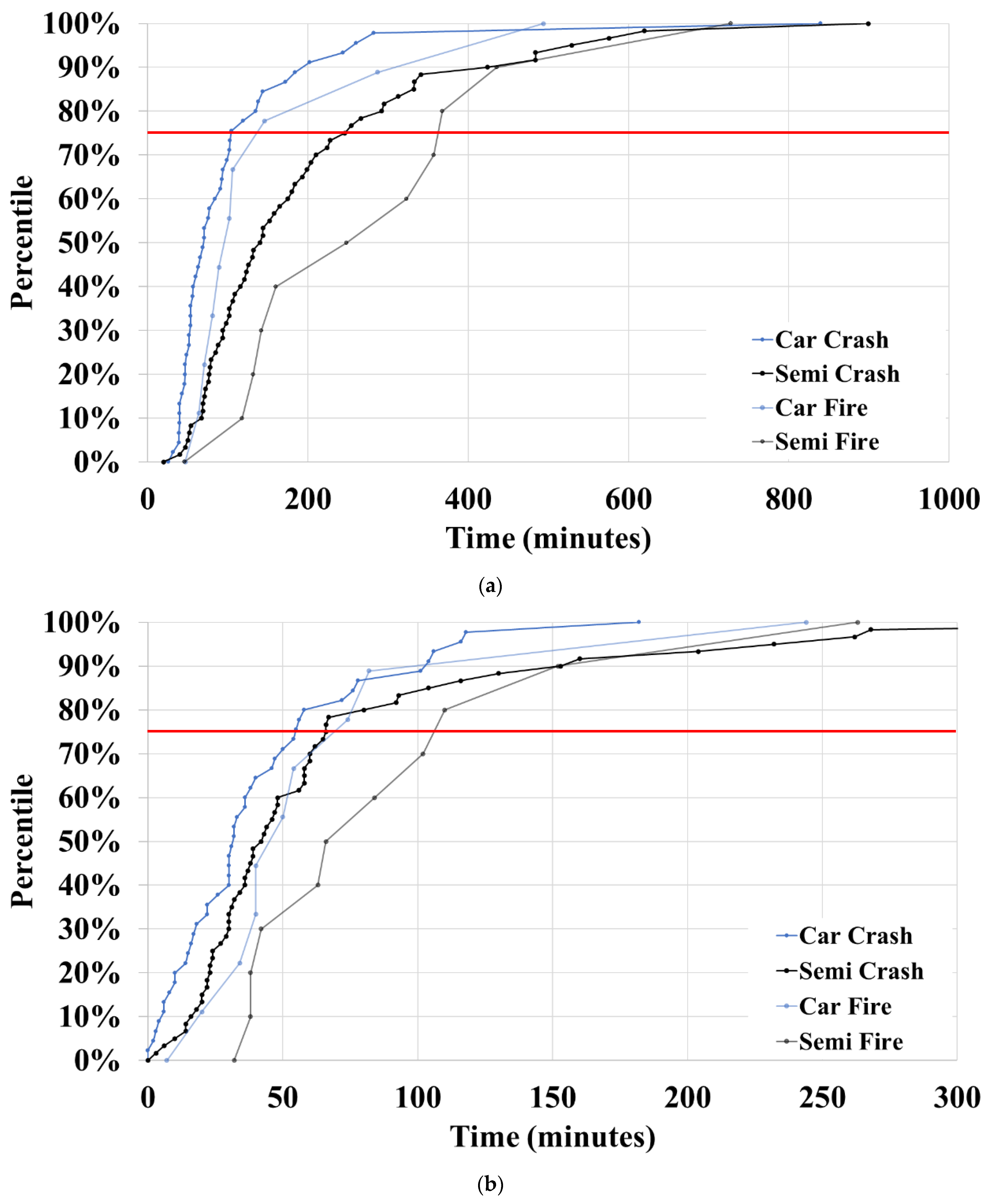
| Ilustration of Incident | Date/ QR Code | Repository ID [20] | RRMT (min) |
|---|---|---|---|
 | 13 December 2024 | 249 | 92 |
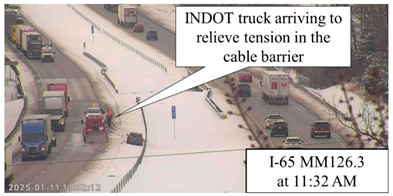 | 11 January 2025 | 426 | 112 |
 | 30 April 2024 | 329 | 34 |
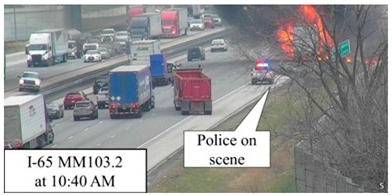 | 19 December 2024 | 246 | 34 |
| TIM Event | Description | Event Time | |||
|---|---|---|---|---|---|
| Case Study 1 | Case Study 2 | Case Study 3 | Case Study 4 | ||
| T0 | Incident Occurs | 11:54 a.m. | 9:08 a.m. | 6:00 p.m. | 10:35 a.m. |
| T1 | Incident Reported | 11:56 a.m. | 9:08 a.m. | 6:00 p.m. | 10:37 a.m. |
| T2 | Incident Verified | 11:56 a.m. | 9:12 a.m. | 6:04 p.m. | 10:40 a.m. |
| T2,eye | ITS Camera on Event | 11:56 a.m. | 9:12 a.m. | 6:04 p.m. | 10:40 a.m. |
| T4 | Response Arrives on Scene | 11:56 a.m. | 9:40 a.m. | 6:08 p.m. | 10:40 a.m. |
| T4,ANRR | All Necessary Recovery Resources | 1:28 p.m. | 11:32 a.m. | 6:42 p.m. | 11:22 a.m. |
| T5 | All Travel Lanes Open | 3:44 p.m. | 12:12 p.m. | 6:26 p.m. | 4:34 p.m. |
| T6 | All Responders Have Left the Scene | 3:44 p.m. | 12:12 p.m. | 7:04 p.m. | 4:34 p.m. |
| T7 | Traffic Conditions Return to Normal | 4:27 p.m. | 12:20 p.m. | 6:46 p.m. | 6:21 p.m. |
| Summary Interval | Formula | Time (min) | |||
|---|---|---|---|---|---|
| Case Study 1 | Case Study 2 | Case Study 3 | Case Study 4 | ||
| Detection Time | T1–T0 | 0 | 0 | 0 | 0 |
| Verification Time | T2–T1 | 2 | 4 | 4 | 3 |
| TMC Verification Time | T2eye–T0 | 2 | 4 | 4 | 5 |
| Response Time | T4–T2 | 0 | 28 | 4 | 0 |
| Recovery Resource Mobilization Time (RRMT) | T4,ANRR–T4 | 92 | 112 | 34 | 34 |
| Roadway Clearance Time (RCT) | T5–T1 | 228 | 184 | 26 | 357 |
| Incident Clearance Time (ICT) | T6–T1 | 228 | 184 | 64 | 357 |
| Time to Return to Normal Flow | T7–T0 | 277 | 192 | 46 | 466 |
Disclaimer/Publisher’s Note: The statements, opinions and data contained in all publications are solely those of the individual author(s) and contributor(s) and not of MDPI and/or the editor(s). MDPI and/or the editor(s) disclaim responsibility for any injury to people or property resulting from any ideas, methods, instructions or products referred to in the content. |
© 2025 by the authors. Licensee MDPI, Basel, Switzerland. This article is an open access article distributed under the terms and conditions of the Creative Commons Attribution (CC BY) license (https://creativecommons.org/licenses/by/4.0/).
Share and Cite
Overall, M.W.; Mukai, J.; Sakhare, R.S.; Desai, J.; Lowther, H.; Bullock, D.M. Measuring the Impact of Recovery Resource Delay on Traffic Incident Management Clearance Times. Future Transp. 2025, 5, 171. https://doi.org/10.3390/futuretransp5040171
Overall MW, Mukai J, Sakhare RS, Desai J, Lowther H, Bullock DM. Measuring the Impact of Recovery Resource Delay on Traffic Incident Management Clearance Times. Future Transportation. 2025; 5(4):171. https://doi.org/10.3390/futuretransp5040171
Chicago/Turabian StyleOverall, Myles W., Justin Mukai, Rahul Suryakant Sakhare, Jairaj Desai, Hillary Lowther, and Darcy M. Bullock. 2025. "Measuring the Impact of Recovery Resource Delay on Traffic Incident Management Clearance Times" Future Transportation 5, no. 4: 171. https://doi.org/10.3390/futuretransp5040171
APA StyleOverall, M. W., Mukai, J., Sakhare, R. S., Desai, J., Lowther, H., & Bullock, D. M. (2025). Measuring the Impact of Recovery Resource Delay on Traffic Incident Management Clearance Times. Future Transportation, 5(4), 171. https://doi.org/10.3390/futuretransp5040171







